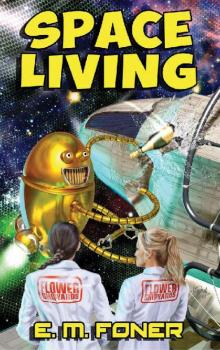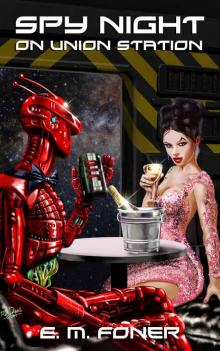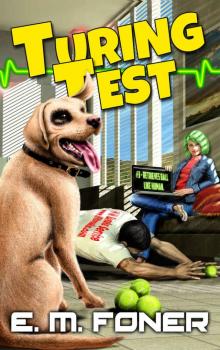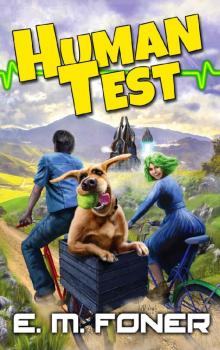- Home
- E. M. Foner
Swap Night on Union Station Page 2
Swap Night on Union Station Read online
Page 2
“But there’s no such thing as psychics, and even if there were, you could hardly figure out which ones were real by having them take a multiple-choice test,” Kelly objected.
“I wouldn’t be so quick to argue with the results of an objective test prepared by a Verlock academy,” the Drazen ambassador cautioned her. “They may not be the best cooks, but they do have the most reputable education system on the tunnel network.”
“A psychic who advertises that she can communicate with the dead?” Kelly asked skeptically as she braced for Beowulf’s greeting. “And what was all that about proof of relationship?”
“It only makes sense,” Bork said, fending off the Cayl hound. “You wouldn’t want to license psychics who were willing to violate the privacy of the deceased. I know enough about your people to say that celebrities would be cheated out of their eternal rest.”
“Now I know you’re just pulling my tentacle,” Kelly said, unconsciously adopting the Drazen expression. “The dead are dead, and nothing you can say is going to convince me otherwise. I have yet to hear of anybody ever being reincarnated—” she shoved away the dog’s massive head again “—other than Beowulf, and his first incarnation was half-alien, so it doesn’t count.”
“How does being half-alien make it not count?” Bork demanded, and then dropped the argument to greet the EarthCent ambassador’s husband. “Hello, Joe. How’s business?”
“I mainly watch Paul do the work these days, and the kids only let me brew enough beer to supply Pub Haggis,” Joe said. “On the bright side, if I was an EarthCent diplomat, I’d have another five years to go before I could retire. Why are you carrying that crumpled-up flyer, Kel?”
“What do you make of this?” she asked, handing it to her husband.
Joe took a moment to read the ad and then shrugged. “Maybe if I thought my parents had buried a treasure they wanted me to know about, but other than that, why disturb them?”
“I didn’t mean it that way. This Madame Zarathustra was subletting the office next to the embassy’s conference room for months and I didn’t even know she was there.”
“That’s because you’re not interested in psychics. Did you ask Donna about it?”
“I haven’t seen her since I found out, but you’re right. If anybody knew what was going on next door it would be her.”
“Are you joining us for dinner, Bork?” Joe asked. “I have a small batch of breakfast stout flavored with coffee that everybody says is too bitter, but it could be just right for you.”
“Thank you, Joe. I’d like to give that a try. I’ll just ping my embassy to tell them I’m taking an early lunch and not to expect me back.”
Two
“Has it really been six months?” Kevin asked his wife as she placed the baby in the bassinet.
“It felt more like six years,” Dorothy said as she tucked the tiny quilt up to her infant son’s chin. “Are you going to miss Daddy?” she asked the baby.
“Ritchie is going to miss me,” the boy’s older sister said. “Why can’t I come to work with you?”
“Because you ask so many questions, Margie. I’d never get any work done,” Dorothy said. “Ritchie just eats and sleeps.”
“I know I promised not to bring it up again,” Kevin began, “but Jeeves offered—”
“La, la, la, la, la,” Dorothy sang while covering her ears. “Somebody needs to look up the definition of promise.”
Kevin sighed and held up his hands just over shoulder-height in a gesture of surrender. “Come on, Margie,” he said to his daughter. “Let’s get the chandlery open, and then Billy and Rachel’s parents asked if you could play with them again today.”
“Preschool starts next week,” Dorothy reminded them. “You’re going to love it, Margie.”
“I want to go to REAL school,” the four-year-old said over Kevin’s shoulder as her father carried her out. “With Stryx.”
“Two more years,” her mother said, holding up two fingers. Then she slung the work bag with her over-sized sketching tab over one shoulder, her purse over the other shoulder, and took up the bassinet. “Let’s go, Richard. Your first day at work.”
Ten minutes later, she set the bassinet down on the conference room table in the new offices of SBJ Fashions. Shaina and Brinda, the sisters who contributed the ‘S’ and ‘B’ to the name of the business, knew better than to wake up a sleeping infant just to make a fuss, but Baa, the Terragram mage who had been given a minority stake due to the importance of her enchanted “Baa’s Bags” brand, whisked off the quilt.
“Just a quick check,” she told Dorothy, inspecting Richard’s hands. “I can count his toes through the snuggly.”
“If a fairy replaced my baby with a changeling, I assure you I’d be the first to know,” Dorothy said tiredly. “I don’t understand how the so-called advanced species can be so superstitious.”
“It’s not just Baa?” Shaina asked.
“Affie gave me a Vergallian ugly-infant mask for him at the baby shower, which is the same thing she gave me for Margie. And Flazint’s matchmaker did the digit-counting thing when she was checking my family’s suitability to act as chaperones.”
“It’s not a superstition,” Baa said, replacing the quilt after satisfying herself on the count of Richard’s toes. “There’s more to the universe than meets the eye, especially the eye of a primitive like yourself.”
“On that note of mutual respect, I declare this post-maternity leave orientation meeting in order,” Jeeves said. The Stryx floated past the women to his accustomed spot at the head of the table and gestured to the younger Hadad sister with his pincer. “Brinda?”
“As the head of sentient resources for SBJ Fashions, I officially declare the end of your six-month maternity leave and reauthorize you for access to the office,” Brinda told Dorothy.
“You could have just trusted me to stay away,” the EarthCent ambassador’s daughter said.
“I’d believe that if you hadn’t made three attempts to get in when nobody was here,” Jeeves retorted. “Did you think I wouldn’t notice an unauthorized individual trying to swipe open the door?”
“I was just going to look through the scrap bin for quilting material,” Dorothy said.
“At four in the morning on your clock after pinging first to see if anybody was in the office?”
“I was up with the baby and I pinged first just to be polite.”
“Listening to you arguing with Jeeves makes it feel like you never went out on maternity leave at all,” Shaina said. “I know that the time I took off from work after having my children helped to give me a fresh perspective when I returned, which is the reason we wanted to hold this meeting right away. Before you go back to your design station, have you had any epiphanies you want to share?”
Dorothy immediately pulled her sketch tab out of her work bag and swiped it to life. “Ever since my mom published the All Species Cookbook with tribute recipes from people living on alien worlds I’ve been working on an idea for tribute clothes. All of our cross-species designs have been intentionally aimed at the largest possible audience, but I’ve been thinking that it would be better to come up with a concept that could be customized for each species.”
“You know that we don’t want to hold a lot of inventory,” Brinda said. “Even if there was a way to maintain a coherent brand with species-specific clothes, we’d have to stock seven or eight times as much merchandise to reach the same number of customers.”
“That’s where the Gem nanofabric comes in,” Dorothy said. “How many representatives are we up to?”
“Sixty-three,” Shaina told her, “but it’s still a Beta program, and ninety percent of them are humans operating virtual boutiques on open worlds. It took the Gem a little longer than we thought to work the kinks out of the rediscovered technology, but now they’re able to supply as much nanofabric as we can buy.”
“Just imagine when we have thousands of sales reps, or tens of thousands. Inventory won’
t matter because we’ll always be shipping the product and everybody will expect delays. It becomes a question of compelling fashions that are worth waiting for. The nanofabric fittings will provide all of the data that Jeeves needs to do the math to map my designs to a Frunge fabric cutting machine, and then—”
“Excuse me?” Jeeves interrupted. “Do you actually expect me to spend my time doing dress math?”
“Just while we’re engineering the workflow,” Dorothy said. “After that, we can replace you with a computer.”
Baa made a noise in the back of her throat, swallowed it, and then burst out laughing. “I think that mapping the data from custom-fit Gem nanofabric to numerically controlled cutting machines would be an excellent use of our Stryx overlord’s time. Don’t forget to leave extra material for the seams, Master of the Multiverse.”
“Putting aside the supply chain and on-demand sewing, I’m not convinced that you have a viable business model,” Jeeves said. “I’m more concerned with Brinda’s initial question, namely, how you are going to maintain a sense of brand styling while attempting to design for a dozen species all at once. And don’t tell me it’s enough to embroider the SBJ logo somewhere to go after customers who only buy designer fashions. Our market research has shown time and time again that our fashions are bought for purpose, not for social signaling.”
“I’d show you right now if my sketch tab would link to the projection system,” Dorothy said, paging through the little-used ‘Settings’ menus in frustration. “Are you sure you’ve reapproved my company credentials for all systems?”
“Positive,” Brinda said. “Have you ever connected using that tab before? I don’t remember seeing it.”
“Paul and Aisha gave it to me for a maternity leave gift. It’s a Dollnick artist’s tab, two sizes up from the student tabs the Open University standardized.”
“And you don’t have any problem connecting at home?”
“I only use it for drawing so I haven’t had any reason to connect to the station networks,” Dorothy said. “I guess I haven’t tried before.”
“Allow me,” Jeeves said, extending his pincer.
Dorothy gave him a distrustful look, but she handed the tab to Baa, who passed it on to the young Stryx artificial intelligence. Jeeves set it down on the conference room table and moved his pincer back and forth just a hair above the surface as if he was dowsing for water.
“I had the tab in my hands for less than two seconds and I diagnosed the issue,” Baa told him. “You’re an embarrassment to your kind.”
“The connectivity issue is obvious,” Jeeves retorted. “The cybercriminals put a lot of effort into hiding their tracks and I’m trying to tease out who they were.”
“Cybercriminals?” Dorothy asked. “You mean somebody has been spying on my design process?”
“That’s exactly what I mean,” Jeeves said, then gave up in disgust and passed the tab back. “The tab will connect now, and I installed a block that will keep snoopers out, but I can’t go any further while limiting myself to techniques known to Human cyber sleuths.”
“Why would you stop there?”
“You know that we allow both diplomatic and industrial espionage on the station because interfering would confer an unearned advantage to the less sophisticated party. Even though I have a material interest in SBJ Fashions, my elders don’t allow me to use advanced techniques that go beyond what you could conceivably do for yourselves.”
“Fortunately, I’m not Stryx,” Baa said, holding the tab up to the side of her face. She closed her cat’s eyes in concentration, and a faint glow appeared between her skin and the tab’s surface.
“Don’t erase anything,” Dorothy pleaded. “The only backup is my memory.”
“I’m not that incompetent,” the Terragram mage replied irritably. “There’s no biological fingerprint, so the culprit could be artificial intelligence, but not a form I recognize.”
“You mean from outside the tunnel network?”
“Or primitive, like a Human-derived AI. Do you get many artificial people coming through Mac’s Bones?”
“Just the ones who work for EarthCent Intelligence,” Dorothy said. “Thomas has been recruiting more of them the last few years, but I’m sure he does background checks and all of that. Wouldn’t the hacking techniques used by an artificial person count as being developed by humanity so that Jeeves could trace them?”
“Not if the artificial person is working as an agent of another species and using their toolkits,” Baa said, returning the over-sized tab to Dorothy. “I suggest that you turn your tab over to Thomas and see if EarthCent Intelligence can detect any traces that will lead them to the double agent. If they can work out the time your tab’s code was altered, that could be sufficient, since the hacker must have been in close proximity.”
“Did you have any of our marketing information and customer lists on the tab or was it just your new designs?” Shaina asked the EarthCent ambassador’s daughter.
“Just my new designs?” Dorothy bristled. “I’ve been working on them for six—well, maybe three months.” The baby made a little noise and everybody froze until he resumed his regular breathing. “I got the tab after you locked me out of the company systems, so, no, I didn’t have any confidential information on it.”
“That’s a relief. We pay serious creds for the station librarian to store all of our data so that it’s one hundred percent secure, but anything downloaded to tabs is fair game for industrial spies.”
“So what do you have to show us?” Brinda asked.
“It’s more of a concept than a finished idea,” Dorothy said. She linked her tab to the conference room’s holographic system which projected a grid of figures wearing skirts and blouses, all drawn in broad strokes, with just the barest bumps for facial features. “Vergallian, Horten, Drazen, Frunge, Human, Gem. These are the six tunnel network species we’ve been targeting with cross-over fashions because our humanoid forms have similar measurements, aside from the occasional tentacle.” She swiped the tab to bring up a new grid of figures. “We also sell handbags, hats, and shoes to the Verlocks, Dollnicks, Grenouthians, Cherts, and Fillinducks, but their bodies are just proportioned too differently for dresses, and the bunnies rarely wear clothes in any case.”
“Even Dollnick fashion houses have difficulty designing for Dollnicks,” Shaina said. “The bone structure supporting the lower set of arms presents a real challenge for creating clean lines. That’s why so many of them go with the two-piece tops.”
“I’ve never been able to adapt my dresses for Dollnicks, and whenever I scale a design to fit a Verlock female, it ends up looking like a tent,” Dorothy said. “The Fillinducks and Cherts almost fit in the first group, but their proportions are off just enough that even with alterations, our fashions just don’t look right. Same with the Sharf, if we start including non-tunnel network humanoids.”
“Why not, it’s only money,” Jeeves said, imbuing his artificial voice with a despondent note.
“But this won’t cost you a cred,” Dorothy said triumphantly, and swiped to a new grid of sketches. The projection included all twelve of the species she had mentioned so far, and the drawings almost looked like they had been done with crayon. But even the shoulder-to-hip sash featured on the Grenouthian somehow conveyed the impression of matching the skirts and blouses worn by the other eleven.
“What exactly am I seeing?” Shaina asked. “Is it just a trick with color coordination that won’t hold up if the drawings aren’t all grouped together?”
“Ye of little faith,” Dorothy said, and swiped the screen for a new projection where the colors and hints of patterns on every figure were different.
Baa half-stood as she peered at the hologram. “As impossible as it sounds, you appear to have stumbled onto a Golden Ratio for cross-species fashion design. I’ve seen a similar method used by Cayl artists when they depict a multi-species group of individuals in a portrait, but it’s a highly advanced conce
pt, and you’re millions of years away from understanding the math.”
“If the idea is copied from the Cayl we may need to get a license,” Jeeves said. “Give all of the details to Tzachan for a legal opinion.”
“I didn’t copy anything from the Cayl,” Dorothy said, “and Tzachan already saw my designs when I chaperoned his date with Flazint last weekend.”
“I’m willing to pay some grudging respect to your artistic instincts, Dorothy, but you don’t come up with a breakthrough like this fooling around for a few months on maternity leave,” Jeeves said.
“I didn’t exactly stumble on it, but it’s not exactly original either,” Dorothy explained. “Plus I had help.” She swiped past a few of the images in her presentation to one that had obviously been captured from another display device via the camera. “Myst signed up for a Gem History course at the Open University because she thought it would be easy. This is one of the pictures from her text that discusses the stagnation of the Gem Empire after they reduced their population to clones of a single individual.”
“So they’re all wearing the same thing,” Shaina said. “How do you go from copies of the same individual all dressing identically to creating a look that maintains its essence across a dozen different species?”
“Look again,” Dorothy said, and began tapping her fingers impatiently when nobody spoke up. “Don’t you see? They aren’t all dressed identically. You just think they are.”
“Because they all look alike?” Brinda asked.
“No, that wouldn’t prove anything. The reason you think they’re all wearing the same jumpsuit is that they’re all cut to the same ratio and feature the same focal points—here, here, and here,” she said, making marks on the tab with a stylus that were immediately duplicated in the hologram. “This particular group of Gem included representatives from all of their colonies, and if you look closely, you’ll see that those jumpsuits are sewn from different fabrics, and the clones themselves vary by at least twenty percent in body mass due to available food sources, gravity, and different oxygen levels on their worlds.”

 Last Night on Union Station (EarthCent Ambassador Book 16)
Last Night on Union Station (EarthCent Ambassador Book 16) Empire Night on Union Station (EarthCent Ambassador Book 18)
Empire Night on Union Station (EarthCent Ambassador Book 18) Space Living (EarthCent Universe Book 4)
Space Living (EarthCent Universe Book 4) Review Night on Union Station (EarthCent Ambassador Book 11)
Review Night on Union Station (EarthCent Ambassador Book 11) Assisted Living
Assisted Living Con Living
Con Living Freelance On The Galactic Tunnel Network
Freelance On The Galactic Tunnel Network Career Night on Union Station
Career Night on Union Station Career Night on Union Station (EarthCent Ambassador Book 15)
Career Night on Union Station (EarthCent Ambassador Book 15) Word Night on Union Station (EarthCent Ambassador Book 9)
Word Night on Union Station (EarthCent Ambassador Book 9) Soup Night on Union Station
Soup Night on Union Station Human Test
Human Test Spy Night on Union Station (EarthCent Ambassador Book 4)
Spy Night on Union Station (EarthCent Ambassador Book 4) Family Night on Union Station (EarthCent Ambassador Book 12)
Family Night on Union Station (EarthCent Ambassador Book 12) Party Night on Union Station (EarthCent Ambassador Book 10)
Party Night on Union Station (EarthCent Ambassador Book 10) Turing Test
Turing Test Alien Night on Union Station (EarthCent Ambassador Book 2)
Alien Night on Union Station (EarthCent Ambassador Book 2) Wanderers On Union Station (EarthCent Ambassador Book 6)
Wanderers On Union Station (EarthCent Ambassador Book 6) Vacation on Union Station (EarthCent Ambassador Book 7)
Vacation on Union Station (EarthCent Ambassador Book 7) Book Night on Union Station (EarthCent Ambassasor 13)
Book Night on Union Station (EarthCent Ambassasor 13) LARP Night on Union Station
LARP Night on Union Station Carnival On Union Station (EarthCent Ambassador Book 5)
Carnival On Union Station (EarthCent Ambassador Book 5) LARP Night on Union Station (EarthCent Ambassador Book 14)
LARP Night on Union Station (EarthCent Ambassador Book 14) Book Night on Union Station
Book Night on Union Station High Priest on Union Station (EarthCent Ambassador Book 3)
High Priest on Union Station (EarthCent Ambassador Book 3) Meghan's Dragon
Meghan's Dragon Human Test (AI Diaries Book 2)
Human Test (AI Diaries Book 2) Guest Night on Union Station
Guest Night on Union Station Date Night on Union Station
Date Night on Union Station